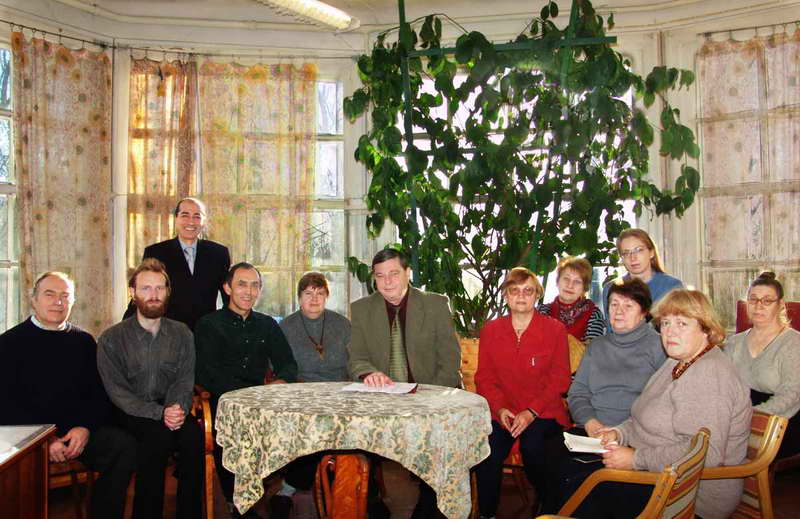To develop molecular-cellular investigations at the Institute, a Group was founded in 1986 and transformed in 1989 into Laboratory of regulation of functions of brain neurons, headed by Biological Sciences Doctor M. O. Samoilov. Included into its staff were researchers of the Laboratory of functional morphology and physiology of neuron, of Group of regulation of brain metabolism, Laboratory of physiology of primates, and in 1997 – of Laboratory of functional neurochemistry.
The main direction of investigations of the Laboratory is study of mechanisms of the synaptic and intracellular signal transduction, which underlie formation of adaptive brain reactions. A large scale is used of laboratory animals and of experimental models (elaboration of simple and complex forms of learning, hypoxic stress, etc.).

Owing to the use of a complex of modern neurophysiological and biochemical methods, it was established that different adaptogenic effects (brief hypoxic stress, tetanic stimulation of neurons, application of antioxidants) increased efficiency synaptic transmission by modifying intracellular mechanisms of the cholinergic and glutamatergic signal transduction mediated by calcium and phosphoinositide regulatory systems. There were revealed regularities of changes in activity of key regulatory systems (calcium, phosphoinositide, cAMP) promoting development of the protecting effect of a short-term hypoxia and antioxidants. A possibility was shown of control of mechanisms of cognitive processes in monkeys by using agonists and antagonists of choline and glutamate receptors as well as by a brief hypoxic effect and antioxidants.
Using models of simple nervous networks on invertebrates (molluscs) and surviving slices of mammalian brain, molecular-cellular mechanisms of formation of elementary forms of learning are studied (sensitization, habituation, long-term post-tetanic potentiation, elaboration of conditional reflex). Peculiarities are revealed of involvement of calcium regulatory system in mechanisms of organization of various forms of learning.
For the first time, in surviving olfactory cortex slices, an interesting phenomenon was discovered: in the course of a long-term posttetanic potentiation as well as after an adaptogenic hypoxic stress, neuromodulatory peptides were released from the cells; these peptides modified synaptic plasticity and increased resistance of neurons to harmful agents. A concept has been put forward about a universal principle of formation of different long-term adaptive brain states at the molecular-cellular level, with involvement of intracellular regulatory systems, genome, neuromodulatory peptides synthesized de novo . A new technology of an increase in the adaptational brain possibilities by efficient activation of mechanisms of the intracellular signal transduction has been proposed. Thus, there has been established an important role of a peptide component of the « three-dimensional » signal transmission in mechanisms of formation of adaptive reaction of brain neurons of different genesis. Identification of these peptides and study of their functional significance are carried out. Thus, experimental evidence has been obtained in favor of participation of component of the “three-dimensional” signal transmission component of the “three-dimensional” signal transmission component of the “three-dimensional” signal transmission – carnosine and heat shock proteins – in plastic adaptive rearrangements of synaptic transmission.
For the recent years, studied intensively are molecular mechanisms of short- and long-term effects of hypoxic preconditioning that increases structural and functional brain resistance to damaging actions. A possibility has been shown of a protective effect of hypoxic preconditioning on disturbances of brain neuron functions and behavioral reactions (exploratory-activity, emotional state, learning, reproduction of acquired skills) evoked by a severe damaging hypoxia. The rapidly induced effects of preconditioning have been found to be due to a moderate activation of intracellular regulatory systems and the glutamatergic signal transduction. Using methods of radioactive in situ hybridization and immunocytochemistry there is revealed involvement of early genes (the family NGFI-A, jun ) and the phenotype-specific late action genes (peptide antioxidants) as well as of their products in realization of long-term effects of hypoxic preconditioning.
Based on the obtained results, a concept has been put forward about a universal principle of formation of different long-term adaptive brain states at the molecular-cellular level, with involvement of intracellular regulatory systems, genome, neuromodulatory peptides synthesized de novo . A new technology of an increase in the adaptational brain possibilities by efficient activation of mechanisms of the intracellular signal transduction has been proposed.
One of perspective directions of investigations developed at the Laboratory at present is study of mechanisms of regulation of expression of genes connected with processes of organization of adaptive behavior. For this purpose, modern molecular-biological methods are used (Western blot hybridization, gel shift assay, etc.). In experiments on the edible snail it gas been established for the first time that involved in elaboration of the defensive conditional reflex are several families of transcriptional factors: CRE, C/EBR, AP-1, Elk-1, whose cascade activation depends on cAMP-induced mitogen-activated and Ńŕ 2+ -dependent intracellular signal system. A suggestion is put forward that disturbance of AP-1 formation and Elk-1 deactivation can be causes of the inability of the animals (specifically, immature snails) to elaborate long-term forms of defensive reflexes. Results of these studies can be used for development of ways of control of gene-dependent mechanisms of formation of adaptive behavior.
The Laboratory carries out complex cooperation studies with a number of Laboratories of the institute as well as with P. K. Anokhin Institute of Normal Physiology of the Russian Academy of Medical Sciences, Institute of Cytology and Genetics of the Siberian Branch of the Russian Academy of Sciences, Department of Neurochemistry of the Medical Research Center of the Polish Academy of Sciences, Institute of Medical Technology and Department of Developmental Biology of Tampere University (Finland), Leeds School of Biochemistry and Molecular Biology (Great Britain).
|